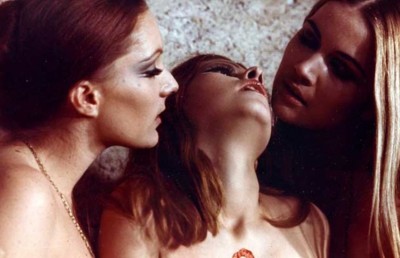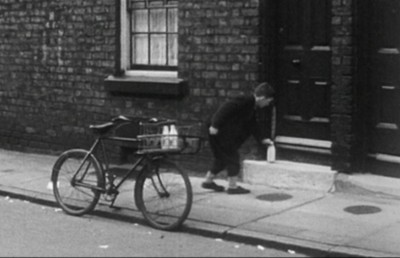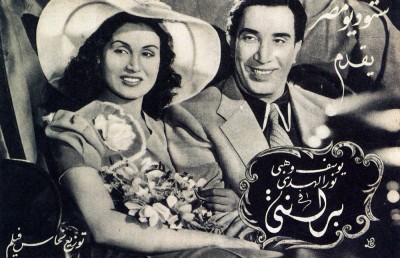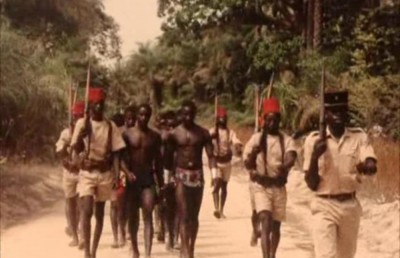Postmortem Evolution of (In-) Organic Life: Peter Greenaway, Bill Morrison, and Film Biochemistry
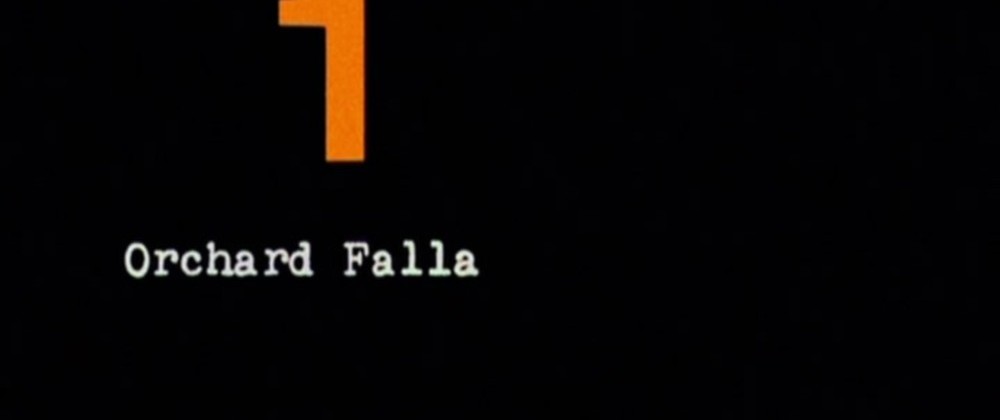
Life is mortal. It lives on its own condition of becoming dead, or if you want, death lives its own life that conditions our life. The notion of postmortem life has yielded cultural fantasies including all variations of the ghost as well as religious dreams, whether Christian resurrection or Buddhist transmigration, and by the same token, ideological illusions which were debunked, especially by so-called “founders of discourse” such as Marx and Nietzsche. These philosophers’ century was also that of Darwin, whose more scientific discourse founded a Copernican biology against the Bible, invoking the idea of an immeasurably gradual yet irreversibly distinct change in life, a change not in an individual but in species. Against this macro-level backdrop of culture and science, I will draw special attention to artistic evolutions of the Darwinian imagination and the obsession with postmortem life at a micro-level of cinema. My case study centers on two filmmakers, Peter Greenaway, an already well-known British director, and Bill Morrison, a yet-to-be-well-known American avant-gardist. I have chosen them because their experiments with ‘life on film’ and ‘film as life’ pose the fundamental question “what is life?” in the most cinematic way.
Among Greenaway’s scientific interests is zoology, particularly ornithology. Setting aside his TV biopic Darwin (1993), my essay spotlights two early fake documentaries that display extraordinary imaginations of men becoming birds: A Walk through H (1978) and The Falls (1980). With the subtitle “The Reincarnation of an Ornithologist,” A Walk through H (1978) is the director’s meditative homage to his ornithologist father, who is said to be the model of the film’s narrator. The invisible narrator relates his posthumous journey of 1418 miles through the gate “H” while watching 92 maps painted by Tulse Luper, Greenaway’s fictive persona. The humanistic symbolism of H –Heaven or Hell– hardly matters in this imaginary wander around an uncharted territory that looks like Byzantine water-color mazes. The camera’s close-dollying over disoriented lines only unfolds a pictorial series of what Deleuze calls “any-space-whatever,” a space without any context in which to locate it objectively. So this might be the most chaotic cartography in which the preceding map is fading, only leaving enigmatic cross-shaped marks. As in a Borgesian virtual world, such a map changes every time, an area having different maps, a route offering many directions, the same event occurring over and over again. This geography therefore maps not an actual plane but, following Deleuze again, an unthinkable spatio-temporality of “the virtual” which is potentially immanent in the actual territory, namely, “the plane of immanence.” It is a geography of an uncharted territory that remains unmappable (fig. 1-2).

Not surprisingly, this “walk though H” starts and ends at the same moment as the narrator’s death, just like Alice’s ‘adventure in a wonderland’ seems to suspend time. Here, the wonderland is that of migratory birds, whose real images are inserted between maps. For Greenaway, this animal stands for the transference to another world by an ultra-human ability of mapping the chaotic air. Thus, the narrator’s pilgrimage to this posthumous world implies a journey from an end to a new beginning. And he “created the territory as he walked through it,” because “the country only existed in its maps.” Indeed, traversing the plane of immanence with no fixed boundary can be a new creation of a map, just as a bird draws a new territory in the indeterminate sky by simply flying over it. In fact, many different cultures share the idea of the departing soul’s taking wing, becoming a bird or using it to travel to the next incarnation. Now the ornithologist becomes a bird, a virtual bird which draws a line of “flight” in its double sense: the man or the animal flees from the organic territorial system, and flies high to temporal openness beyond the actual progress of time. By doing so, the bird-ornithologist “deterritorializes” the geographical system into non-systematic openness; or say, it allows the system itself to draw a line of flight, to become a bird, as its territory is drawn and redrawn by the human bird (fig. 3-4).
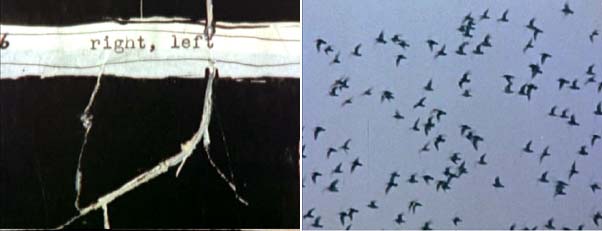
With mesmerizing flapping sounds, the beautiful cross-cut between moving maps and flying birds epitomizes this becoming. At a glance the birds seem to navigate the maps, but the editing magically alludes to becoming-bird of the maps themselves. Then the time-space conjunction is broken with abysmal interstices that rapidly emerge between images as well as between the image, sound, and silence of the narrator, who perhaps is in process of becoming-bird, of losing language. Far from religious reincarnation, this Deleuzian becoming-animal is not becoming another animal organism. Neither dead nor alive, it expresses an inorganic life as pure intensity, quality, and power of “becoming” as such (fig. 5-6).
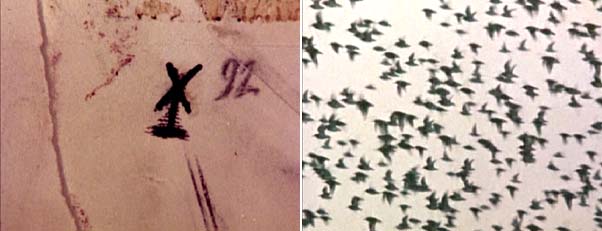
Let me take a walk to the next film, The Falls, which multiplies this becoming-animal in an encyclopedic matrix. A statistical and biographical fantasy of an absurdist apocalypse, the film presents 92 victims of the Violent Unknown Event (VUE), which has caused immortality, disability, and 92 new peculiar languages. From a VUE Doomsday Directory are chosen the sufferers whose surnames begin with the letters FALL; among them, some really “fall” from buildings and Icarus-style homemade wings, and others literally become “falls” such as a human waterfall and a man renamed Niagara. More important, various symptoms of man’s metamorphosis into bird recall the hubristic ambition of flying, suggesting the VUE as a modern Babel myth about the end of civilization (the title also invokes fallout). Such eschatological concerns provoke nonsensical conspiracy theories on the event. For example, “Obsian Fallicut had a theory that the VUE was an expensive elaborate hoax perpetuated by A.J. Hitchcock to give some credibility to the unsettling and unsatisfactory ending of his film, The Birds.” (This theory wears away the affection of his wife, Raspara.) The world then resembles a chaosmos of paranoia/schizophrenia as in the novels by Thomas Pynchon or Italo Calvino (fig. 7-8).
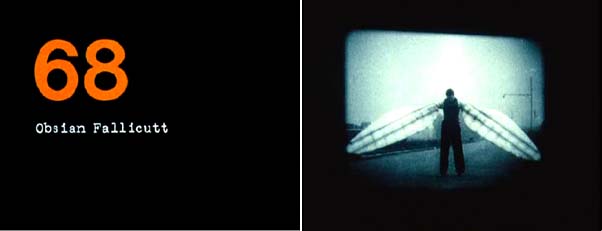
Despite all apocalyptic scenarios it depicts, however, The Falls does not appear as a Kubrick-style black comedy or a science fiction with a dystopian vision of the future. The Directory system neither organically classifies nor rationally explains victims and causes of the VUE, but this attack of what Lacan terms “the Real,” like the birds’ attack in Hitchcock’s film, brings about a somewhat jovial disorder of the system, and produces various patterns of becoming-bird in the actual world. In effect, the apocalypse might already have been realized by the VUE, which makes time “out of joint,” opening not a Judgment-Day, nor even just a posthumous life, but a post-apocalyptic new world drawing multiple lines of flight: diverse languages, changes of sex, identity, and skin, physical deformities, and even a dog’s becoming-bird. Such a collective schizophrenia would be no less than a molecular revolution of deterritorializing all solidified boundaries and differences into a communal “body without organs” in Deleuze and Guattari’s terms. Conversely, the human “devolution” to the animal actualizes this immanent global body as an alternative world of the human’s becoming other and even immortal by embodying the eternal return of becoming per se (fig. 9-10).
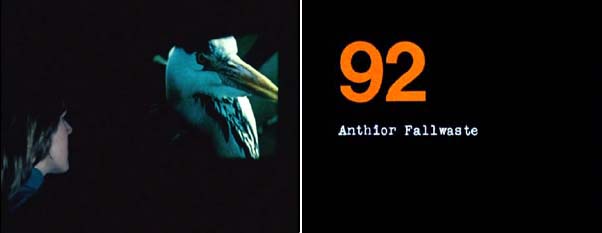
Coincidentally The Falls came out in the same year as Deleuze and Guattari’s A Thousand Plateaus, as if it were 92 cinematic plateaus that decentralize the tree-shape “molar” system to the rhizomatous “molecular” non-system. What falls down is the vertically organized symbolic system; the system of “tabula,” the grid of classical utopia of language and totality of knowledge. The classical Encyclopedists invented the alphabetical tabula for the Enlightenment, but Greenaway, like Sade, pushes it to extremes until the randomness and arbitrariness of the system debunk it and create open-ended, non-definitive essays written in vertiginous digressions. So The Falls replaces the classical utopia by what Foucault calls “heterotopia,” a completely different “order of things” in which an archivist is a potential anarchist and the human embraces the inhuman. As a hydra-headed “browse film,” it realizes Bakhtinian polyphony with 92 voices that tell “a history of all the subjects who inhabit it.” Through the VUE as the most irrational interstice, the history unfolds on the continuum of infinite differentiations. The intervals between shots and voices flap like birds on the rhythm of Michael Nyman’s fake baroque-style ritornello loops and Brian Eno’s molecular ambient sounds. And systems are on the verge of becoming birds (fig. 11-12).
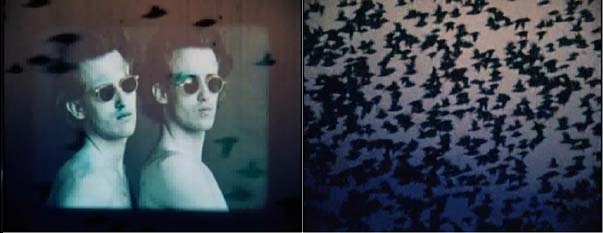
What is life in this postmodern evolution? Let me here take a detour via two concepts of “the Sublime” in Kant: in opposition to the Beautiful as having boundaries, the Sublime as boundlessness can be either “dynamic” (having enormous power that causes fear [fig. 13]) or “mathematical” (showing absolute greatness beyond measurability [fig. 14]). If fearful death as invincible destiny is a dynamically sublime moment, A Walk through H turns it into the pathway towards a mathematically sublime territory with no boundaries. Man encounters too many birds there, while becoming part of this mathematically sublime multitude. The Falls takes a further step; the dynamic sublime of the VUE that is uncontrollable by human power brings about the mathematical sublime of numerous human beings becoming numerous human birds. In fact, 92 is the atomic number of uranium which foreshadows the dynamism of nuclear explosion, but it may also suggest innumerability as if caused by nuclear fission, just like 92 maps and 92 episodes.
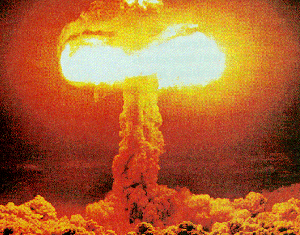

The cinema of catastrophe usually represents either of the two sublime modes: nuclear bombing-like disasters on the dynamic side, and animal or alien attacks in multitude on the mathematical side. Greenaway’s post-catastrophic films, however, take a dynamically sublime event as the threshold beyond which an unprecedented, even positively imaginable world emerges on the mathematically sublime plane for pure becoming. The animal ontology of being in a multitude – animals exist in a herd, a flock, a pack, a school, a swarm, etc., i.e. without individuality – is the condition of liberating the human from its own cage of individualism and organic systems. The organic life is then dissolved into inorganic relations of endless transformations and transgressions. Immortality as a post-apocalyptic symptom is significant, because pure becoming is, again, not rigidified as an organism that must be alive or dead, but rather, undead. A singular body without organs as an undead life traverses and mingles with the net of multiple symptoms and potentials of becoming: the net as a social body without organs. Greenaway evolves Darwinism into Deleuzian bio-philosophy.
Greenaway’s later works are more suggestive in this shift of the mathematical sublime to a new social condition of changing/changed life, not at the level of content but of film form. His “post-films” such as Prospero’s Books (1991 [fig. 15]) and The Pillow Book (1996 [fig. 16-17]) experiment with multiple screens and ever-forking narratives that, in theory, can infinitely pulverize the traditional screen and narrative as a unified time-space conjunction.


A series of installation-exhibitions such as The Physical Self (1991) and The Stairs (1994 [fig. 18-19]) project onto cityscapes and civic architecture 100 cinematic objects that stand for unlimited seriality. The trilogy of The Tulse Luper Suitcases (2003-4 [fig. 20]) peaks in this trend of “expanded cinema,” and Greenaway performs VJ with its gallery version A Life in Suitcases (2005 [http://www.youtube.com/watch?v=qs3aOt62jV8&feature=related]). Pregnant is “life.” 92 suitcases seem nothing but infinite digital interfaces which the spectator touches with his fingers as digits so as to be bodily engaged and incorporated into a new social space, an ever-rebooting feedback circuit of multidirectional parameters and indeterminate modulations. This embodiment of active participation certainly empowers the spectator’s subjectivity more than the traditional cinema. A viewer then becomes a doer, user, player, even a director who creates a film by connecting fragmented images and information, as Greenaway intends.


But we should note that there is an unintended effect, that this empowerment might be a new-media version of the postmortem (d)evolution of life. Only by “plugging in” the apparently infinite but actually finite network can Luper’s and the spectator’s life be activated at once. No longer entity or identity, the subject is constituted as an agent put in the objective net of inorganically lurking contingencies. Subjectivity and objectivity are then the relational effects of interfaciality, which is visualized as interfacial images that surround life and immerse it into the undead world. In this sense, the digital revolution seems to just accelerate the (d)evolution of life that has been ongoing through modern mechanical reproduction and postmodern simulacra culture. Greenaway’s often surrealist juxtapositions of incongruent products or diverse media might even be a digital update of what Rancière calls “the aesthetic regime” that started in the early 19th century and evolved into modernist art. It was a new order in which different arts and sensibilities can be combined and redistributed without being bound by representational rules, with fusion, hybridity, or deconstruction becoming keywords of its aesthetic principle.
“The ethical turn of the aesthetic” in Rancière’s context is partly the extension of this regime, in that the mathematical sublime underlies what he calls the “soft ethical” in which any differences should be tolerated on the ever-globalized plane of harmonious mutilculturalism. The other side of the turn, the “hard ethical,” however, warns of the ever-increasing risk inherent in this entropy of global interfaciality, just as the internet as a virtual universe always entails the possibility of its total breakdown by terrorism-like virus attacks. Historically, Rancière says, such catastrophes as the Holocaust and Hiroshima triggered the ethical turn, so our mathematically sublime new-media society might be already post-apocalyptic, yet foreshadowing a dynamically sublime apocalypse. In brief, our subjectivity “enjoys” the symptom of becoming undead only by accepting interfaciality as its ontological condition, on which our image and information can be reprocessed while becoming another interface that can float over the relational virtual realm forever. But we also live this undead life only on the surface of interfaces under which the magma that could bring the maximum extermination is boiling all the time.
For my final point, let me briefly look at Bill Morrison, moving from Greenaway’s earlier imagination of a postmortem life on screen, through his later experiment with life in the new media screen culture, towards a hidden life of the innermost infrastructure of the cinema, that is, the film strip. Among others who belong to the found footage tradition, Morrison clearly explores the so-called “cinema of ruins” that show how celluloid decays. His short films such as The Mesmerist (2003) and Light is Calling (2004 [fig. 21-24]) result from an optical reprinting of early half-decayed silent films as seen through the rolling emulsion of the nitrate cellulose itself – this material is no longer used because of the vinegar syndrome, which is the irreversible chemical process of decomposition affecting prints struck on cellulose diacetate and triacetate.


What matters is thus not just how the film represents a virtual evolution of organic life, but how it presents its own material death and postmortem rebirth. Greenaway’s film biology A Zed and Two Noughts (ZOO, 1985 [fig. 25-28]), which partly documents animal decay, may be a key link to Morrison’s film chemistry. If Greenaway records and thereby preserves the duration of life’s becoming death so that the cinema accomplishes its ontological mission of being a permanent index to a present being or event, the cinema in Morrison turns this indexicality back into itself by being a self-referential evidence of its own quasi-organic mortal life. Hardly fulfilling what Bazin calls the “mummy complex,” the cinema then becomes a burning memento mori, while those already dead actors, who look however still alive on screen, indeed appear like ghosts who barely live their postmortem life.


The feature-length film Decasia (2004) exposes this poetic archeology of cinema from the title, accompanied by Michael Gordon’s uncanny symphony. It rediscovers and resurrects not just one short film, but a bunch of unidentified, forgotten films in the way that this redemption of dead celluloid only proves the real death of that chemical material. This paradox implies a double facet. First, Decasia itself is an impressive montage that connects diverse and divergent images, going back and forth between diegetic and nondiegetic, fictional and documentary, concrete and abstract, realistic and surrealist. This chaotic but also synthetic combination partly revolves around the frequent image of turn and spin, which may symbolize the rotation of the film reel that unfolds an endless series of scenes, shots, and frames. In other words, it is the mathematical sublime that we could locate along this horizontal axis of the editing and montage in general, of the film strip itself and of its temporality on screen. The succession of images is thus quantitatively additive and theoretically infinite (fig. 29-30).
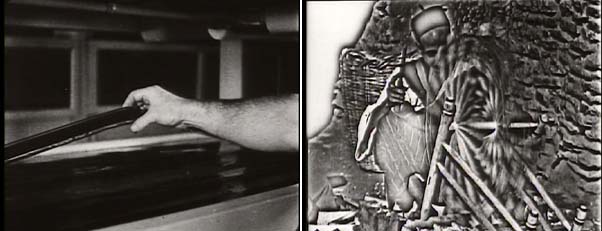
Second, however, all these seemingly undead images cannot help but experience a kind of qualitative leap in its vertical temporality. The fundamental change of their ontological state from undead to rotten, then, expresses what the director calls “a non-human intervention,” “Higher Power,” namely, the dynamic sublime of death, which is already passed or always deferred in Greenaway. When a boxer who was training in the source footage looks here desperate for untangling himself out of this sublime destiny, the original narration gives way to, or rather, takes afresh on ruination. All the “visual noise” that time has inscribed on the film strip, along with negative, flickering, or blurring effects, transforms the stable screen of the solid world into a liquid screen with ectoplasmic bubbling blobs. All that is organic melts into this inorganic body without organs, while the inorganic film turns out to have had a quasi-organic life that would dissolve into the same inorganic state along with what it would dissolve. The film strip might be a Mobius strip of organic and inorganic lives (fig. 31-32).
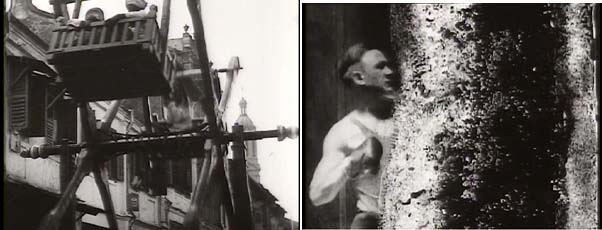
Someone says: “every image is, always, simultaneously, an image of ruin, an image about the ruin of the image.” Any catastrophe represented on screen might be nothing but a veiled index to the potential catastrophe immanent in the organic life of the film. From Greenaway to Morrison, we return from the dream of the undead to our mortal reality. But then, a naïve question might be raised: doesn’t the digital restoration of Morrison’s Decasia to DVD in turn render the film really undead? Is that immaterial matrix of innumerable 0s and 1s, that mathematical sublime of the digital, the only dream space for postmortem life? This is not easy to answer, for even at this moment my digits that will someday decay are now putting digital codes into this antiseptic computer screen (fig. 33-34).
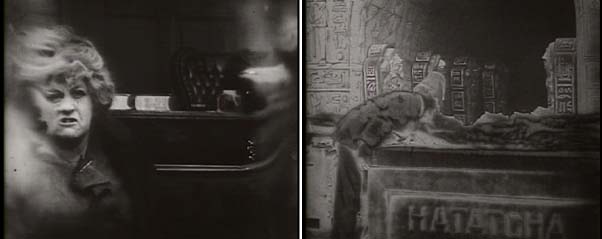
*This essay was presented at the symposium “Natural Dialogues: Art, Science, & Material Culture” held at Yale Center for British Art (February, 2009).
References
Deleuze, Gilles. Cinéma 1: l’image-movement and Cinéma 2: l’image-temps. Paris: Minuit, 1983 and 1985.
Deleuze, Gilles, and Félix Guattari. Mille Plateaux: capitalisme et schizophrénie 2. Paris: Minuit, 1980.
Elsaesser, Thomas. “Spellbound by Peter Greenaway: In the Dark … and Into the Light.” In European Cinema: Face to Face with Hollywood. Amsterdam: Amsterdam UP, 2005. 178-92.
Foucault, Michel. “Different Spaces.” In Essential Works of Michel Foucault, Volume 2: Aesthetics, Epistemology, Methodology. Ed. James D. Faubion. New York: The New Press, 1998, 175-185.
Habib, André. “Thinking in the Ruins: Around the Films of Bill Morrison.” In Offscreen (November 2004).
——-. “Matter and Memory: A Conversation with Bill Morrison.” In Offscreen (November 2004).
——-. “Le temps décomposé: ruines et cinema.” In Protée 35.2 (2007): 15-26.
Kant, Immanuel. Critique of the Power of Judgment. Trans. and eds. Paul Guyer and Eric Matthews. Cambridge: Cambridge UP, 2000.
Rancière, Jacques. “Le trounant éthique de l’esthéthique et de la politique. Malaise dans l’esthétique. Paris: Galilée, 2004, 143-73.


